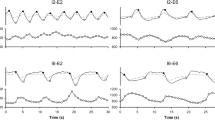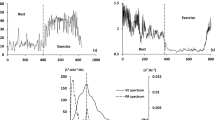Abstract
Purpose
The deceleration capacity (DC) and acceleration capacity (AC) of heart rate as well as the respiratory rate predict outcome after acute myocardial infarction. We evaluated the relation between breathing frequency and both DC and AC, as well as the difference between them.
Methods
We studied fourteen healthy young adults who breathed spontaneously and controlled their breathing to rates of 0.1, 0.2, 0.3, and 0.4 Hz in a supine position. A 5-min R–R interval time series without movement artifacts or ectopic beats was obtained from each studied period and scanned to identify the anchor points that were characterized by a value longer or shorter than the preceding value. Averaged changes of R–R intervals surrounding the deceleration and acceleration anchors were calculated as DC and AC, respectively.
Results
The magnitudes of DC and AC increased progressively as breathing frequency decreased (Both p < 0.001 by one-way repeated-measures analysis of variance). The magnitude of DC was larger than the magnitude of AC during 0.1-Hz breathing (95 % confidence interval of their difference: 1.7–9.7 ms), while the difference between them reduced to near zero at higher frequencies.
Conclusions
Slow breathing enhances the magnitudes of DC and AC simultaneously under the conditions used in this study. The increase in the magnitude of DC is significantly greater than that of AC.

Similar content being viewed by others
Abbreviations
- AC:
-
Acceleration capacity
- DC:
-
Deceleration capacity
- ECG:
-
Electrocardiography
- HRAGI :
-
Guzik’s index of heart rate asymmetry
- HRV:
-
Heart rate variability
- MI:
-
Myocardial infarction
- MSNA:
-
Muscle sympathetic nerve activity
- PRSA:
-
Phase-rectified signal averaging
- RRI:
-
R–R interval
- SR:
-
Spontaneous respiration
References
Barthel P, Wensel R, Bauer A, Muller A, Wolf P, Ulm K, Huster KM, Francis DP, Malik M, Schmidt G (2013) Respiratory rate predicts outcome after acute myocardial infarction: a prospective cohort study. Eur Heart J 34(22):1644–1650. doi:10.1093/eurheartj/ehs420
Bauer A, Kantelhardt JW, Barthel P, Schneider R, Makikallio T, Ulm K, Hnatkova K, Schomig A, Huikuri H, Bunde A, Malik M, Schmidt G (2006a) Deceleration capacity of heart rate as a predictor of mortality after myocardial infarction: cohort study. Lancet 367(9523):1674–1681. doi:10.1016/S0140-6736(06)68735-7
Bauer A, Kantelhardt JW, Bunde A, Barthel P, Schneider R, Malik M, Schmidt G (2006b) Phase-rectified signal averaging detects quasi-periodicities in non-stationary data. Phys A 364:423–434. doi:10.1016/j.physa.2005.08.080
Brown TE, Beightol LA, Koh J, Eckberg DL (1993) Important influence of respiration on human R–R interval power spectra is largely ignored. J Appl Physiol 75(5):2310–2317
Campana LM, Owens RL, Clifford GD, Pittman SD, Malhotra A (2010) Phase-rectified signal averaging as a sensitive index of autonomic changes with aging. J Appl Physiol 108(6):1668–1673. doi:10.1152/japplphysiol.00013.2010
Dommasch M, Sinnecker D, Barthel P, Muller A, Dirschinger RJ, Hapfelmeier A, Huster KM, Laugwitz KL, Malik M, Schmidt G (2014) Nocturnal respiratory rate predicts non-sudden cardiac death in survivors of acute myocardial infarction. J Am Coll Cardiol 63(22):2432–2433. doi:10.1016/j.jacc.2014.02.525
Eames PJ, Potter JF, Panerai RB (2004) Influence of controlled breathing patterns on cerebrovascular autoregulation and cardiac baroreceptor sensitivity. Clin Sci 106(2):155–162. doi:10.1042/CS20030194
Eckberg DL (2003) The human respiratory gate. J Physiol 548(Pt 2):339–352. doi:10.1113/jphysiol.2002.037192
Grossman P, Karemaker J, Wieling W (1991) Prediction of tonic parasympathetic cardiac control using respiratory sinus arrhythmia: the need for respiratory control. Psychophysiology 28(2):201–216
Guzik P, Piskorski J, Krauze T, Wykretowicz A, Wysocki H (2006) Heart rate asymmetry by Poincare plots of RR intervals. Biomed Tech 51(4):272–275. doi:10.1515/BMT.2006.054
Guzik P, Piskorski J, Contreras P, Migliaro ER (2010) Asymmetrical properties of heart rate variability in type 1 diabetes. Clin Auton Res 20(4):255–257. doi:10.1007/s10286-010-0057-7
Hayano J, Mukai S, Sakakibara M, Okada A, Takata K, Fujinami T (1994) Effects of respiratory interval on vagal modulation of heart rate. Am J Physiol 267(1 Pt 2):H33–H40
Henry RA, Lu IL, Beightol LA, Eckberg DL (1998) Interactions between CO2 chemoreflexes and arterial baroreflexes. Am J Physiol 274(6 Pt 2):H2177–H2187
Hirsch JA, Bishop B (1981) Respiratory sinus arrhythmia in humans: how breathing pattern modulates heart rate. Am J Physiol 241(4):H620–H629
Joseph CN, Porta C, Casucci G, Casiraghi N, Maffeis M, Rossi M, Bernardi L (2005) Slow breathing improves arterial baroreflex sensitivity and decreases blood pressure in essential hypertension. Hypertension 46(4):714–718. doi:10.1161/01.HYP.0000179581.68566.7d
Katona PG, Poitras JW, Barnett GO, Terry BS (1970) Cardiac vagal efferent activity and heart period in the carotid sinus reflex. Am J Physiol 218(4):1030–1037
Klintworth A, Ajtay Z, Paljunite A, Szabados S, Hejjel L (2012) Heart rate asymmetry follows the inspiration/expiration ratio in healthy volunteers. Physiol Meas 33(10):1717–1731. doi:10.1088/0967-3334/33/10/1717
Novak V, Novak P, de Champlain J, Le Blanc AR, Martin R, Nadeau R (1993) Influence of respiration on heart rate and blood pressure fluctuations. J Appl Physiol 74(2):617–626
Pomeranz B, Macaulay RJ, Caudill MA, Kutz I, Adam D, Gordon D, Kilborn KM, Barger AC, Shannon DC, Cohen RJ et al (1985) Assessment of autonomic function in humans by heart rate spectral analysis. Am J Physiol 248(1 Pt 2):H151–H153
Radaelli A, Raco R, Perfetti P, Viola A, Azzellino A, Signorini MG, Ferrari AU (2004) Effects of slow, controlled breathing on baroreceptor control of heart rate and blood pressure in healthy men. J Hypertens 22(7):1361–1370
Raupach T, Bahr F, Herrmann P, Luethje L, Heusser K, Hasenfuss G, Bernardi L, Andreas S (2008) Slow breathing reduces sympathoexcitation in COPD. Eur Respir J 32(2):387–392. doi:10.1183/09031936.00109607
Ricca-Mallada R, Migliaro ER, Piskorski J, Guzik P (2012) Exercise training slows down heart rate and improves deceleration and acceleration capacity in patients with heart failure. J Electrocardiol 45(3):214–219. doi:10.1016/j.jelectrocard.2012.01.002
Rudas L, Crossman AA, Morillo CA, Halliwill JR, Tahvanainen KU, Kuusela TA, Eckberg DL (1999) Human sympathetic and vagal baroreflex responses to sequential nitroprusside and phenylephrine. Am J Physiol 276(5 Pt 2):H1691–H1698
Seals DR, Suwarno NO, Dempsey JA (1990) Influence of lung volume on sympathetic nerve discharge in normal humans. Circ Res 67(1):130–141
Sin PYW, Galletly DC, Tzeng YC (2010) Influence of breathing frequency on the pattern of respiratory sinus arrhythmia and blood pressure: old questions revisited. Am J Physiol Heart Circ Physiol 298(5):H1588–H1599. doi:10.1152/ajpheart.00036.2010
Taha BH, Simon PM, Dempsey JA, Skatrud JB, Iber C (1995) Respiratory sinus arrhythmia in humans: an obligatory role for vagal feedback from the lungs. J Appl Physiol 78(2):638–645
Thayer JF, Yamamoto SS, Brosschot JF (2010) The relationship of autonomic imbalance, heart rate variability and cardiovascular disease risk factors. Int J Cardiol 141(2):122–131. doi:10.1016/j.ijcard.2009.09.543
Wang YP, Kuo TBJ, Lai CT, Lee GS, Yang CCH (2012) Effects of breathing frequency on baroreflex effectiveness index and spontaneous baroreflex sensitivity derived by sequence analysis. J Hypertens 30(11):2151–2158. doi:10.1097/HJH.0b013e328357ff46
Wang YP, Kuo TBJ, Lai CT, Chu JW, Yang CCH (2013) Effects of respiratory time ratio on heart rate variability and spontaneous baroreflex sensitivity. J Appl Physiol 115(11):1648–1655. doi:10.1152/japplphysiol.00163.2013
Wang YP, Kuo TBJ, Yang CCH (2014) A possible explanation for the effects of respiration on heart rate and blood pressure asymmetry. Int J Cardiol 174(3):805–807. doi:10.1016/j.ijcard.2014.04.152
Acknowledgments
This work was supported by a grant (10201-62-062) from Taipei City Hospital (Taiwan) and a grant (102MG09) from Science Park Administration, National Science Council. The authors did not receive any financial support from any manufacturer. The authors take full responsibility for the experimental design, data collection, data analysis, and the interpretation of the findings. We thank Ms Chieh-Wen Chen for her technical assistance.
Author information
Authors and Affiliations
Corresponding author
Ethics declarations
Conflicts of interest
There are no conflicts of interest.
Additional information
Communicated by Keith Phillip George.
Rights and permissions
About this article
Cite this article
Wang, YP., Kuo, T.B.J., Lai, CT. et al. Effects of breathing frequency on the heart rate deceleration capacity and heart rate acceleration capacity. Eur J Appl Physiol 115, 2415–2420 (2015). https://doi.org/10.1007/s00421-015-3219-4
Received:
Accepted:
Published:
Issue Date:
DOI: https://doi.org/10.1007/s00421-015-3219-4




